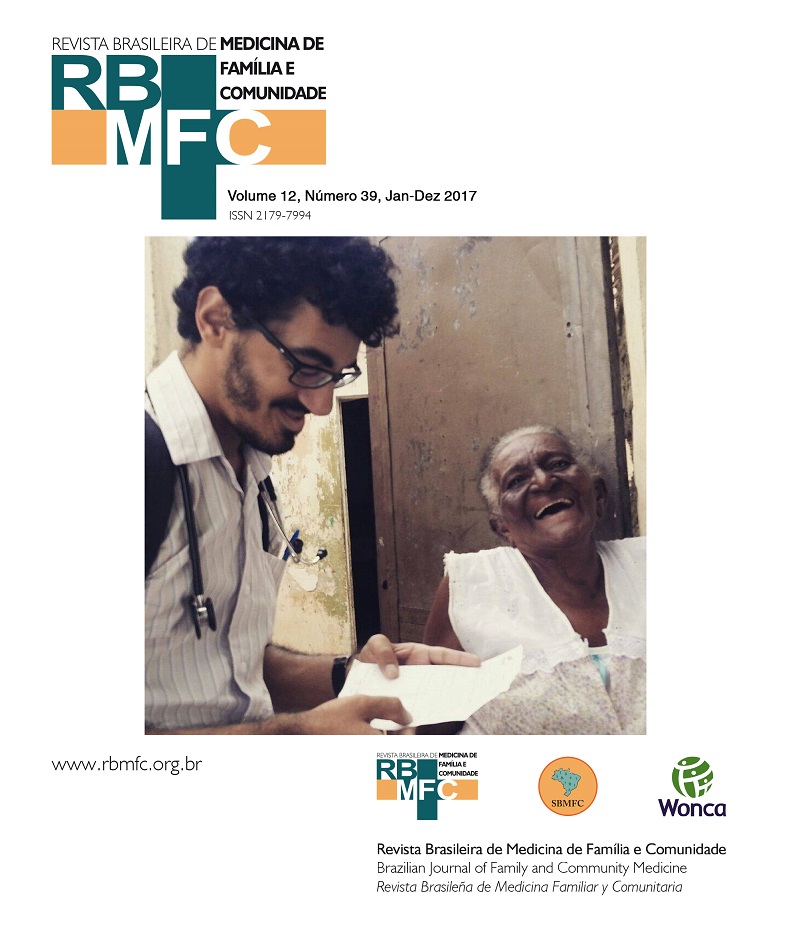Cuidados paliativos oncológicos em um serviço público de atenção domiciliar
DOI:
https://doi.org/10.5712/rbmfc12(39)1339Palavras-chave:
Cuidados Paliativos. Oncologia. Serviços de Assistência Domiciliar. Sistema Único de SaúdeResumo
Objetivo: Identificar o perfil dos pacientes com câncer e em cuidados paliativos e suas demandas referentes ao atendimento multidisciplinar existente em um Serviço de Atenção Domiciliar. Métodos: Estudo transversal com coleta de dados secundários dos pacientes oncológicos em cuidados paliativos atendidos pelo Programa de Atenção Domiciliar do Grupo Hospitalar Conceição, no ano de 2013. Aprovado pelo Comitê de Ética e Pesquisa sob o número 13.203. Resultados: Foram acompanhados 63 pacientes com diagnóstico de neoplasia. Dentre esses, 71,5% (n=45) estavam em cuidados paliativos. As medianas do tempo de acompanhamento dos pacientes foram de 22 (3-146) dias e do número de visitas realizadas pela equipe foi 6 (1-34). Além das visitas semanais realizadas pelas equipes, os pacientes receberam assistência de nutricionista, fisioterapeuta e assistente social. Considerando as 45 internações, os principais cuidados foram controle da dor, curativos em feridas, controle glicêmico, e antibioticoterapia endovenosa. A principal intercorrência clínica foi a repassagem de cateter nasoenteral (n=5). A alta em condições estáveis de saúde ocorreu em 10 pacientes. Conclusão: O presente estudo permitiu a identificação das principais demandas dos pacientes em cuidados paliativos oncológicos atendidos por um serviço de Atenção Domiciliar. Observa-se na prática deste serviço que a maioria dos pacientes apresentou necessidade de cuidados complexos, mas possíveis de serem realizados no domicílio pela equipe de saúde e/ou cuidador capacitado.
Downloads
Métricas
Referências
World Health Organization (WHO). Global status report on noncommunicable diseases 2010. Geneva: WHO; 2011.
Brasil. Ministério da Saúde. Portaria Nº 874 de 16 de Maio de 2013. Institui a Política Nacional para a Prevenção e Controle do Câncer na Rede de Atenção à Saúde das Pessoas com Doenças Crônicas no âmbito do Sistema Único de Saúde (SUS). Brasília: Ministério da Saúde; 2013.
World Health Organization (WHO). National Cancer control Programmes: Policies and managerial guidelines world. Geneva: WHO; 2002.
Mendes EC, Vasconcellos LCF. Cuidados paliativos no câncer e os princípios doutrinários do SUS. Saúde Debate. 2015;39(106):881-92. DOI: https://doi.org/10.1590/0103-1104201510600030026
Brasil. Ministério da Saúde. Portaria Nº 825 de 25 de abril de 2016. Redefine a Atenção Domiciliar no âmbito do Sistema Único de Saúde (SUS) e atualiza as equipes habilitadas. Brasília: Ministério da Saúde; 2016.
Brasil. Ministério da Saúde. Portaria Nº 2.527 de 27 de Outubro de 2011. Redefine a Atenção Domiciliar no âmbito do Sistema Único de Saúde (SUS). Brasília: Ministério da Saúde; 2011.
Organização Mundial da Saúde. CID-10: classificação estatistica internacional de doenças e problemas relacionados a saúde. São Paulo: EDUSP, 1997. p.1191.
British Association for Enteral and Parenteral Nutrition. The MUST Explanatory Booklet. A guide to malnutrition universal screening tool (MUST) for adults. Malnutrition Advisory Group (MAG). [acesso 2014 Out
. Disponível em:
http://www.bapen.org.uk/pdfs/must/must_explan.pdf
Reis-Pina P, Lawlor PG, Barbosa A. Cancer-Related Pain Management and the Optimal Use of Opioids. Acta Med Port. 2015;28(3):376-81. DOI: http://dx.doi.org/10.20344/amp.5801 DOI: https://doi.org/10.20344/amp.5801
Velloso M, Jardim JR. Funcionalidade do paciente com doença pulmonar obstrutiva crônica e técnicas de conservação de energia. J Bras Pneumol. 2006;32(6):580-6. DOI: http://dx.doi.org/10.1590/S1806-37132006000600017 DOI: https://doi.org/10.1590/S1806-37132006000600017
García de Paredes ML, del Moral González F, Martínez del Prado P, Martí Ciriquián JL, Enrech Francés S, Cobo Dols M, et al. First evidence of oncologic neuropathic pain prevalence after screening 8615 cancer patients. Results of the On study. Ann Oncol. 2011;22(4):924-30. DOI: https://doi.org/10.1093/annonc/mdq449
Roberto A, Deandrea S, Greco MT, Corli O, Negri E, Pizzuto M, et al. Prevalence of Neuropathic Pain in Cancer Patients: Pooled Estimates From a Systematic Review of Published Literature and Results From a Survey Conducted in 50 Italian Palliative Care Centers. J Pain Symptom Manage. 2016;51(6):1091-102.e4. DOI: http://dx.doi.org/10.1016/j.jpainsymman.2015.12.336 DOI: https://doi.org/10.1016/j.jpainsymman.2015.12.336
Mercadante S. Breakthrough pain in cancer patients: prevalence, mechanisms and treatment options. Curr Opin Anaesthesiol. 2015;28(5):559-64. DOI: http://dx.doi.org/10.1097/ACO.0000000000000224 DOI: https://doi.org/10.1097/ACO.0000000000000224
Løhre ET, Klepstad P, Bennett MI, Brunelli C, Caraceni A, Fainsinger RL, et al. From “Breakthrough” to “Episodic” Cancer Pain? A European Association for Palliative Care Research Network Expert Delphi Survey Toward a Common Terminology and Classification of Transient Cancer Pain Exacerbations. J Pain Symptom Manage. 2016;51(6):1013-9. DOI: http://dx.doi.org/10.1016/j.jpainsymman.2015.12.329 DOI: https://doi.org/10.1016/j.jpainsymman.2015.12.329
Aguiar RM, Silva GRC. Os cuidados de enfermagem em feridas neoplásicas na assistência paliativa. Rev Hosp Univ Pedro Ernesto. 2012;11(2):82-8.
Agreda JJS, Bou JET. Atenção integral nos cuidados das feridas crônicas. Petrópolis: EPUB; 2012.
Brasil. Ministério da Saúde. Instituto Nacional de Câncer José de Alencar - INCA. Consenso Nacional de Nutrição Oncológica. Brasília: Ministério da Saúde; 2011.
Floriani CA, Schramm FR. Desafios morais e operacionais na inclusão dos cuidados paliativos na rede de atenção básica. Cad Saúde Pública. 2007;23(9):2072-80. DOI: http://dx.doi.org/10.1590/S0102-311X2007000900015 DOI: https://doi.org/10.1590/S0102-311X2007000900015
Gomes B, Calanzani N, Gysels M, Hall S, Higginson IJ. Heterogeneity and changes in preferences for dying at home: a systematic review. BMC Palliat Care. 2013;12:7. DOI: http://dx.doi.org/10.1186/1472-684X-12-7 DOI: https://doi.org/10.1186/1472-684X-12-7
Pereira PBA. Atenção domiciliar e produção do cuidado: apostas e desafios atuais [Dissertação de mestrado]. São Paulo: Universidade Federal de São Paulo; 2014.
Oliveira Neto AV, Dias MB. Atenção Domiciliar no Sistema Único de Saúde (SUS): o que representou o Programa Melhor em Casa? Divulg Saúde Debate. 2014;51:58-71.
Dias MB, Savassi LCM, Nunes MRMTP, Zachi MLR. A Política Nacional de Atenção Domiciliar no Brasil: potencialidades, desafios e a valorização necessária da atenção primária à saúde. J Manag Prim Heal Care. 2015;6(1):1-7.
Savassi LCM. Os atuais desafios da Atenção Domiciliar na Atenção Primária à Saúde: uma análise na perspectiva do Sistema Único de Saúde. Rev Bras Med Fam Comunidade. 2016;11(38):1-12. DOI: http://dx.doi.org/10.5712/rbmfc11(38)1259 DOI: https://doi.org/10.5712/rbmfc11(38)1259
Downloads
Publicado
Como Citar
Edição
Seção
Licença
Ao submeterem um manuscrito à RBMFC, os autores mantêm a titularidade dos direitos autorais sobre o artigo, e autorizam a RBMFC a publicar esse manuscrito sob a licença Creative Commons Atribuição 4.0 e identificar-se como veículo de sua publicação original.














